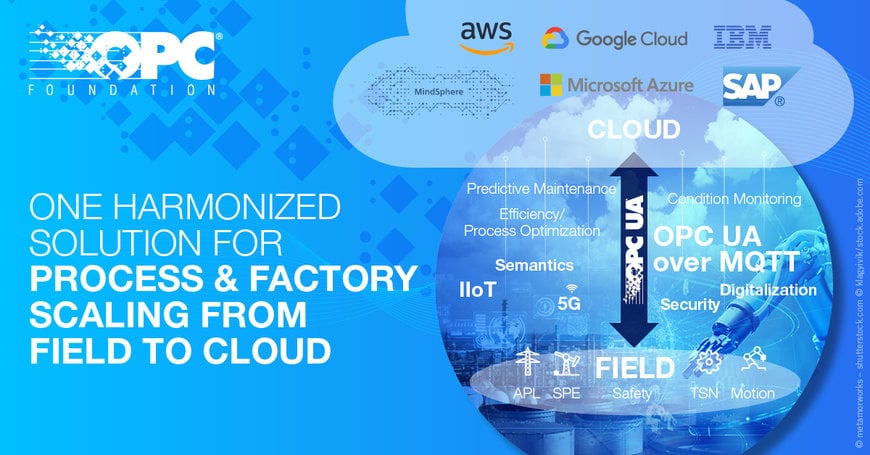www.magazine-industry-usa.com
08
'22
Written on Modified on
Leading IoT Vendors Commit to OPC UA Adoption
Major IoT vendors including AWS, Google Cloud, IBM, Microsoft, SAP and SIEMENS leverage secure, standardized information exchange in edge-to-cloud applications based on OPC UA

Leading Internet-of-Things (IoT) vendors are adopting OPC UA technology for edge-to-cloud applications. The growing list includes Amazon Web Services (AWS), Google Cloud, IBM, Microsoft, SAP and SIEMENS.
Key drivers behind this progression are, first and foremost, the global adoption of OPC UA as the open standard of choice for secure production-system interoperability across OT and IT networks, leveraging standardized data exchange. As such, there are over 850 registered OPC Foundation members supporting a large, rapidly growing eco-system of end-users, standards bodies, and vendors.
Second, OPC UA uses a standardized method of defining, discovering, and using Information Models (IMs) and services associated with the production systems. This standardized approach to semantic information sharing prevents vendor lock-in and costly custom programming needed for non-standard IM ingestion in the cloud. With the launch of the UA Cloud Library, OPC UA IMs are globally available to all cloud applications, making it easy for cloud applications to directly utilize OPC UA-based semantic information as well as live data coming from the edge.
Third, as a transport-agnostic, IEC standard, OPC UA is supporting two different communication patterns: Client/Server (over e.g. TCP or WebSockets) as well as Publish/Subscribe (over e.g. UDP or MQTT) to meet different industry requirements from the production systems to edge and cloud scenarios.
Fourth, the quality assurance program of the OPC Foundation extends to the OPC UA Publish/Subscribe communication patterns and forms the first multi-vendor, multi-cloud standard. Interoperability workshops, including leading PLC vendors, like Beckhoff and Siemens, sending OPC UA data from the controller, over MQTT, have already started.
Fifth, end users benefit from and eagerly welcome the commitment from major IoT vendors that support OPC UA as a standard for IoT communications. Stefan Hoppe, President of the OPC Foundation says: “It’s thrilling to see that OPC UA is the one solution harmonized for process and factory automation, scaling from field to cloud (and back). The continued vision of the OPC Foundation – to establish OPC UA as THE open standard of choice for data interoperability throughout the world of automation – started and flourished with controllers and visualization systems and has now reached IT & the cloud. This will lead to a further growth of the open eco-system, based on OPC UA.”
The criteria for companies to be listed with these features is that they either support OPC UA over MQTT in their products today or that it is on their development roadmap.
See the testimonials from IT/OT companies:
-AWS
Sanat Joshi, Managing Director, Manufacturing Industry Solutions, AWS:
“AWS understands the complexity of industrial data connectivity and the challenges manufacturers and industrial customers face implementing IIoT and Industry 4.0 applications. This is why AWS has a portfolio of services that extend cloud functionality into industrial operations to provide industrial edge capability. With AWS IoT Greengrass and SiteWise connecter, manufacturers can securely ingest OPC UA-based data onto AWS with open data access for real-time visualization, analytics, and machine learning to drive operational efficiencies, innovation, scalability, and agility.”
-BECKHOFF
Sven Goldstein, Product manager Connectivity, BECKHOFF:
”Beckhoff is the first automation vendor to support OPC UA Pub/Sub using both UDP and MQTT. The requirement to connect industrial assets in a secured and standardized format to the cloud is of utmost importance and an emerging topic in all industry sectors. With its PC-based control architecture, Beckhoff can easily adapt new communication technologies to enable machine builders to connect their assets directly to the cloud.”
-Google Cloud
Charlie Sheridan, Global Technical Directory Manufacturing, Automotive & Energy - Google Cloud:
"Google Cloud is committed to openness and industry collaboration. By contributing to and leveraging the OPC UA Cloud Library, we can enable "cloud-based" access to OPC UA information models for our customers and partners. OPC UA will be our way of incorporating machine data into our data analytics and AI capabilities, to ultimately deliver on the promise of accessible data and easy-to-use AI across factories."
-IBM
Ulas Cubuk, IBM App Connect for Manufacturing Product Manager, IBM:
"IBM has a long-running partnership with OPC Foundation. OPC Foundation’s dedication to ensuring interoperability in automation was the number one choice for this partnership. We had a long journey in helping our customers to build patterns to publicize OPC UA messages via MQTT. Now we want to step up this game by adapting the OPC UA PubSub specification."
-Microsoft
Erich Barnstedt, Chief Architect Standards & Consortia, Azure IoT, Microsoft Corporation:
“Microsoft was the first vendor to support OPC UA PubSub over MQTT when we launched Microsoft OPC Publisher in 2016. Additionally, Microsoft has been working with the OPC Foundation on the OPC UA PubSub specification since the beginning.”
-SAP
Claudius Link, Senior Vice President Engineering Manufacturing and Industrial IoT at SAP SE:
“SAP welcomes the evolution of standards to solve issues in the customer’s reality – today, hybrid cloud and edge computing solutions are becoming the norm and the basis for many customers to accelerate their digital transformation. As a member of the OPC Foundation, SAP is committed to simplifying the integration of industrial and business operations, based on open communication patterns as defined by the OPC Foundation.”
-Siemens
Melanie Ruhe, Head of Global Product Management MindSphere:
“Siemens Mindsphere is fully committed to OPC UA with its powerful data modelling capabilities and rich platform services to effortlessly connect shopfloor devices.”

